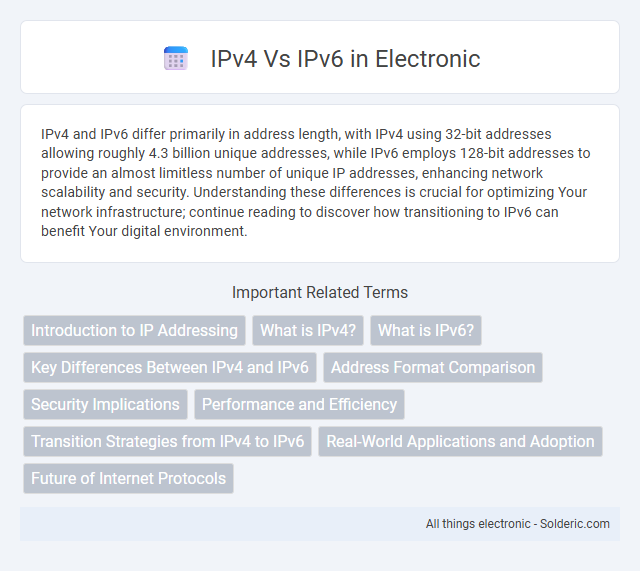IPv4 and IPv6 differ primarily in address length, with IPv4 using 32-bit addresses allowing roughly 4.3 billion unique addresses, while IPv6 employs 128-bit addresses to provide an almost limitless number of unique IP addresses, enhancing network scalability and security. Understanding these differences is crucial for optimizing Your network infrastructure; continue reading to discover how transitioning to IPv6 can benefit Your digital environment.
Comparison Table
| Feature | IPv4 | IPv6 |
|---|---|---|
| Address Length | 32 bits | 128 bits |
| Address Format | Decimal (e.g., 192.168.1.1) | Hexadecimal (e.g., 2001:0db8::1) |
| Address Space | Approximately 4.3 billion addresses | Approximately 3.4x10^38 addresses |
| Header Size | 20 bytes | 40 bytes |
| Configuration | Manual or DHCP | Auto-configuration (stateless/stateful) |
| Security | Optional (IPSec support optional) | Mandatory IPSec support |
| Fragmentation | Handled by sender and routers | Handled only by sender |
| Broadcast | Supported | Not supported; uses multicast instead |
| Checksum | Included | Removed for efficiency |
| Compatibility | Widely used, legacy devices supported | Growing adoption, not backward compatible |
Introduction to IP Addressing
IPv4 uses a 32-bit address format allowing approximately 4.3 billion unique addresses, which has led to address exhaustion with the growth of internet-connected devices. IPv6 addresses this limitation with a 128-bit format, supporting 3.4 x 10^38 unique addresses, enabling scalability for the expanding digital landscape. Both protocols provide hierarchical addressing and routing, but IPv6 introduces enhanced features such as simplified header format and improved security with built-in IPsec.
What is IPv4?
IPv4 (Internet Protocol version 4) is a widely used IP addressing system that utilizes a 32-bit address format, allowing for approximately 4.3 billion unique addresses. It facilitates communication between devices on a network by assigning numerical identifiers to each device. Your network devices rely on IPv4 for routing and addressing, but the limited address space has prompted the transition to IPv6.
What is IPv6?
IPv6 is the latest version of the Internet Protocol designed to replace IPv4, offering a vastly larger address space with 128-bit addresses compared to IPv4's 32-bit system. This expansion enables trillions of unique IP addresses, solving the limitation issues faced by IPv4 and ensuring scalable internet growth. Your devices benefit from enhanced security features and better network efficiency inherent in IPv6.
Key Differences Between IPv4 and IPv6
IPv4 uses a 32-bit address scheme allowing for 4.3 billion unique addresses, whereas IPv6 employs a 128-bit scheme, vastly expanding available IP addresses to accommodate the exponential growth of internet-connected devices. IPv4 relies on manual or DHCP address configuration, while IPv6 supports auto-configuration capabilities, enhancing network efficiency and reducing administrative overhead. Security features are integrated into IPv6 with mandatory IPsec support, providing improved data integrity and confidentiality compared to the optional implementation in IPv4.
Address Format Comparison
IPv4 addresses consist of 32 bits, represented as four decimal numbers separated by periods, such as 192.168.0.1, allowing approximately 4.3 billion unique addresses. IPv6 addresses use 128 bits, expressed as eight groups of four hexadecimal digits separated by colons, like 2001:0db8:85a3:0000:0000:8a2e:0370:7334, enabling a vastly larger address space. Understanding these distinct address formats is essential for configuring Your network devices and ensuring proper IP protocol compatibility.
Security Implications
IPv6 enhances security by natively supporting IPsec, providing improved confidentiality, integrity, and authentication compared to IPv4, where IPsec is optional and less consistently implemented. IPv4's widespread use and exhaustion of address space increase reliance on Network Address Translation (NAT), complicating security and reducing transparency. Transition mechanisms between IPv4 and IPv6 may introduce vulnerabilities, making proper configuration and monitoring essential to maintain robust security postures.
Performance and Efficiency
IPv6 offers enhanced performance over IPv4 through efficient routing and simplified packet headers, which reduce processing overhead on routers and devices. The larger address space in IPv6 eliminates the need for network address translation (NAT), improving end-to-end connectivity and reducing latency. IPv6 also supports improved multicast and anycast capabilities, optimizing bandwidth usage and enhancing network efficiency.
Transition Strategies from IPv4 to IPv6
Transition strategies from IPv4 to IPv6 primarily involve dual-stack implementation, where devices run both protocols simultaneously to ensure compatibility. Tunneling techniques, such as 6to4 and Teredo, encapsulate IPv6 traffic within IPv4 packets, enabling communication across IPv4 infrastructure. Network Address Translation 64 (NAT64) facilitates interaction between IPv6 clients and IPv4 servers, easing the migration to a fully IPv6-enabled network.
Real-World Applications and Adoption
IPv4 remains predominant in real-world applications due to its extensive compatibility with existing network infrastructure and devices, especially in enterprise and legacy systems worldwide. IPv6 adoption is accelerating in regions with high internet growth and among cloud service providers, offering enhanced security features and an expanded address space sufficient for billions of connected devices. Major internet service providers (ISPs) and content delivery networks (CDNs) have increasingly implemented IPv6 to support IoT deployments and future-proof network scalability.
Future of Internet Protocols
IPv6 addresses the limitations of IPv4 by providing an exponentially larger address space with 340 undecillion unique addresses, ensuring scalability for the growing number of internet-connected devices. The transition to IPv6 enhances security with built-in IPsec support and improves routing efficiency and network autoconfiguration, making it crucial for the future of internet infrastructure. Embracing IPv6 today future-proofs your network against the exhaustion of IPv4 addresses and supports the expansion of IoT, smart cities, and next-generation digital services.
IPv4 vs IPv6 Infographic

 solderic.com
solderic.com